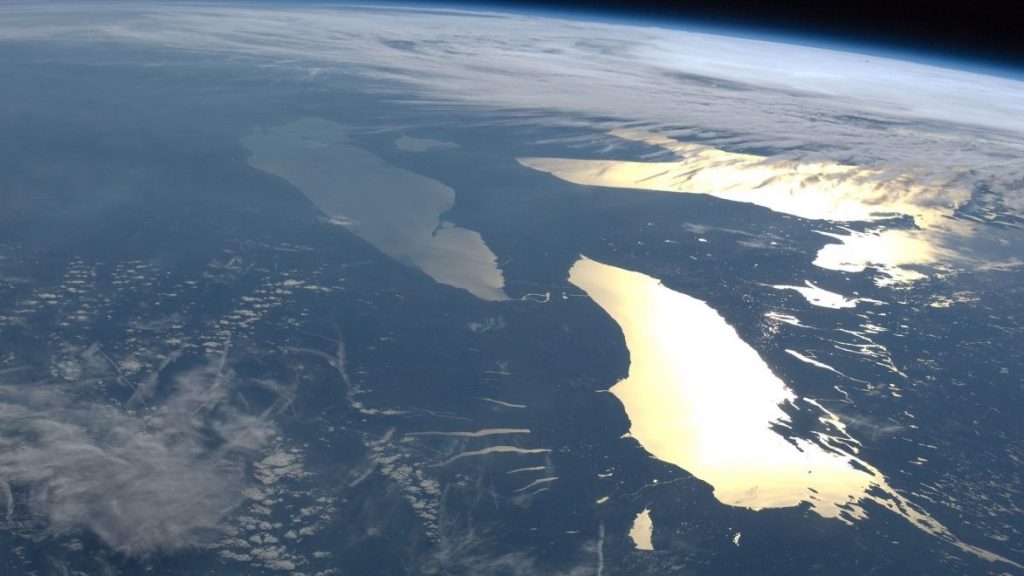From MQR Volume L, Issue 3: The Great Lakes: Love Song and Lament, Summer 2011. The full text is available in our Archive. Please join MQR, the Hopwood Program, and the Great Lakes Theme Semester on February 25th for a celebration of Great Lakes Literature.
This land, surrounded and surmounted by waters; this underappreciated and overexploited provincial backwater deep in the belly of North America; this quiltwork landscape of woodlots and cornfields, of cutover forests and vestigial prairies, of industrial parks and subdivisions and bunched-up cities on the shore, of bedrock and dunes and glacial hills and limestone scarps and so many ecologically sensitive rivers, lakes, swamps, bogs, fens, marshes, sloughs, and frog ponds that frustrated shopping-mall developers from Minneapolis to Montreal are tearing out their hair and stomping on kittens; just flyover country for the power elite until they want something from it; once hailed as the Great Northwest Territory and now a geographically amorphous swath across the Upper Midwest and Lower Canada, reaching not quite to New England and the Maritimes in the east and not quite to the Heartland in the west, though Heartland virtues persist here even as the farms and factories that cultivated them wither; where the trees, trout, beaver, iron, copper, oil, topsoil, water views, and labor pool have always been ripe for plundering but are damned near depleted now; where sacrifices that fueled the rise of empires while draining most of the profits away have rarely been acknowledged and never recompensed; where five astonishing seas of fresh water that once were as secure as money in the bank remain our epicenter, our capital, our strength, and our delight but are no longer very secure; this land that is as sprawling and messy, gorgeous and ugly, dynamic, diverse, complex, perplexing, heartening and heartbreaking as the two nations that encircle it—this is my home.
It is not an easy place to know. Nor is any place. Many explorers of the near at hand have demonstrated that one lifetime isn’t enough to learn a county, a town, even a backyard. Walk a trail a dozen times, and you remain a stranger to it. A hundred times, and you might earn a nodding acquaintance. Walk it in snow, in rain, alone and in company with kids and dogs and friends, under a full moon and a new moon, in the fog, with your eyes shut and your feet seeking the way by touch, and maybe you’ll become familiar enough to call it by name. But do you know it?
When children memorize a song or a poem they say they have “learned it by heart.” I’m trying to learn this land, my home, by heart. But I don’t know if my heart is big enough.
And I don’t know if I’m writing a love song or a lament.
Both, probably. Both and more. For a complex subject requires a complex song.
Here are some of the most beautiful places in North America, and the ugliest. Some of the cleanest, and the most fouled. Some of the richest, and the poorest.
Here are the Rust Belt, the Corn Belt, and the Sweetwater Coast.
Here are legislative suckholes and key battlegrounds of presidential elections.
Here is the neck of the funnel of the economic outpourings of two great nations, but the money seldom stays here.
Here is Cornucopia, spewer of soybeans and taconite; of ethanol and Buffalo wings; of steel and wheat and Wheaties; of sugar beets and cherries and crushed stone and bird’s-eye maple and Ford trucks and ginseng; of Labatt and Miller Lite; of copy paper and deep-dish pizza; of corn flakes, Vernors, disposable diapers, butter, blueberries, yellow perch, and Christmas trees.
Here is energy flow—the hub of airlines and pipelines, of steel rails, interstates, and freshwater freeways—and the terminus of orphan trains, the Underground Railroad, and the Hillbilly Highway.
Here is a place so large that it’s overlooked, so familiar that it’s invisible, so beloved that it’s despised, so precious that we’re intent upon ransacking it. It is shot through with stunning natural beauty, but the world notices mostly the sullied and degraded. It’s home to tens of millions of people divided, as everywhere, between those who care and those who don’t give a rat’s ass, and most of whom dream of going south in the winter.
If it were smaller, it would be more appreciated. If it were under the aegis of a single state, province, or tribal nation, it would be better safeguarded. If it had a primary identity—swampy, like the Everglades; estuarial, like the Chesapeake; alpine, like the Sierra Nevada—it would be understood. But it sprawls across borders. It has a hundred identities. It lacks a dominant mythology. It is too immense to grasp, too varied to brand, too tarnished to romanticize.
It is land held together by water. That is one feature shared throughout. An ocean of freshwater. A rolling, rushing, surging, gushing, lapping abundance of water, enough to slake the thirst of nations, enough to float a civilization, enough to be the envy of the world. It’s a mother lode—the mother lode—and we cherish it, ignore it, hoard it, waste it, guzzle it, cleanse our sins in it, and use it as a toilet.
Let this be a celebration, then, and a grieving. Both a love song and a lament. A tribute to what was and a plea for what remains




